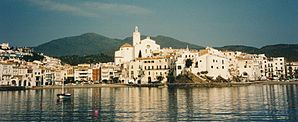Cadaqués
| Cadaqués municipality | ||
|---|---|---|

|
||
| coat of arms | Map of Spain | |

|
|
|
| Basic data | ||
| Autonomous Community : | Catalonia | |
| Province : | Girona | |
| Comarca : | Alt Empordà | |
| Coordinates | 42 ° 17 ′ N , 3 ° 17 ′ E | |
| Height : | 23 msnm | |
| Area : | 26 km² | |
| Residents : | 2,712 (Jan 1, 2019) | |
| Population density : | 104.31 inhabitants / km² | |
| Municipality number ( INE ): | 17032 | |
| administration | ||
| Official language : | Castilian , Catalan | |
| Mayor : | Maria Pia Seriñana Torrents | |
| Website : | www.cadaques.cat | |
Cadaqués ( cat . [ Kəðəˈkes ]) is a former fishing village with 2712 inhabitants (as of January 1, 2019) on the Costa Brava in Catalonia ( Spain ). A large part of it is located on the Cap de Creus peninsula in a bay open to the sea. Due to its remote location in a mountain range on the edge of the Alt Empordà , Cadaqués has always been separated from the rest of the Empordà .
history
Viticulture, which flourished in the 18th century, fell into a crisis at the end of the 19th century when phylloxera appeared . The remote location of the village initially led to extensive stagnation and impoverishment. With the advent of tourism at the beginning of the 20th century, however, Cadaqués gained economic attractiveness due to its idyllic location.
The old town center is dominated by the outwardly simple Gothic church of Santa Maria above the main street, which has one of the most important baroque altars in Catalonia from the 18th century. Some well-known artists such as Federico García Lorca , Pablo Picasso and Joan Miró visited Cadaqués and contributed to the popularity of the place. Salvador Dalí spent part of his childhood in Cadaqués; his father's family owned a house there. After his return from New York, Dalí settled on Portlligat Bay by the harbor. The place then became more and more of a magnet for artists: André Breton , Gabriel García Márquez , Luis Buñuel , Marcel Duchamp , Paul Éluard , Max Ernst , Jo Micovich , Maurice Boitel , Man Ray and others were drawn to the charisma of Cadaqué.
The former Perrot Moore Museum is now closed, but was bought by the municipality in 2005 and is to be used again for the public. The blue and white Casa Serinyena is located near the beach in a modernist style. An open-air cinema is organized in summer. A classical music festival with the participation of well-known artists takes place regularly in August. To the north, Dalí's British agent John Peter Moore had a large area fenced in, to which a road leads to the lighthouse at the tip of the Cap de Creus. The road to the south to Roses crosses the mountains and offers many views of the Bay of Roses. The place is now a popular tourist destination; In the summer months, the number of visitors temporarily exceeds the number of residents by more than ten times.
Attractions
The following attractions in Cadaqués are of cultural, historical and tourist interest:
- Salvador Dalí's house (meanwhile converted into a museum; in Portlligat)
- Gothic church of Santa Maria from the 16th to 19th centuries
- Baroque altar by Pau Costa and Joan Torras in the 18th century church of Santa Maria
- Church of Sant Sebastià from the 18th century
- Hermitage of Sant Baldiri from the 18th century
Others
The name Cadaqués is probably due to the juniper (Catalan cádecs ) that grows on the Cap de Creus .
gallery
Salvador Dalí's statue
Web links
- Cadaqués website (Catalan)
- Cadaqués Alt Empordà. (pdf, 451 kB) Generalitat de Catalunya, February 20, 2004, archived from the original on May 21, 2006 (Catalan, topographic map and data).
- Cadaqués. In: Catalunya Magazine. 2010, archived from the original on February 10, 2011 .
- Cadaqués. In: CapCreus online - newspaper for the Costa Brava. Archived from the original on January 19, 2013 .
- Gala - Salvador Dali Foundation. (Catalan, Spanish, English, French, Chinese).
Individual evidence
- ↑ Cifras oficiales de población resultantes de la revisión del Padrón municipal a 1 de enero . Population statistics from the Instituto Nacional de Estadística (population update).
- ↑ Retaules barrocs de Santa Maria. In: festacatalunya.cat. 2006, accessed August 8, 2018 (Catalan).
- ^ Cadaqués (Alt Empordà): Elements d'interès històrico-artístic. Retrieved August 8, 2018 (Catalan).
- ↑ Cristina Masanes Casaponsa, Susanne Engler: Cadaqués. Triangle Postals, Sant Lluís (Menorca), 2004, ISBN 84-8478-141-0 , p. 130.






